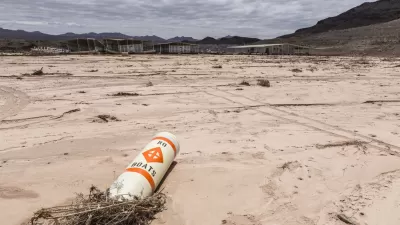With warmer temperatures sapping the flow of water and communities clamoring for higher volumes, the Colorado River needs strict management to continue serving millions of people and farms.

The Colorado River, which supplies water to 40 million people in seven western states, faces a crisis as its resources are stretched thin and climate change threatens its future. Its two largest reservoirs, Lake Mead and Lake Powell, are both below 50% capacity, and the drying trend continues as rainfall in the region remains lower than normal. Sammy Roth interviewed Jeff Kightlinger, the general manager of Southern California's Metropolitan Water District, the entity responsible for operating the Colorado River Aqueduct and distributing water to almost 19 million people.
Kightlinger admits there are formidable challenges facing Southern California as climate change accelerates warmer and drier conditions and growing populations demand more water. He suggests that the Imperial Irrigation District (IID), which serves the Imperial Valley and uses the largest share of the Colorado River's water, must "become a responsible, reliable" partner in the Drought Contingency Plan that California and neighboring states have developed in order to manage the Colorado's limited resources. The IID wants to see more resources directed toward stabilizing the Salton Sea, a major ecological challenge for the area.
"The next 25 years look like it’s going to be a real hard haul," Kightlinger says, "but I believe it’s doable, as long as the parties can be smart and work together."
FULL STORY: Boiling Point: Climate change spells trouble for the Colorado River. But there’s still hope

Planetizen Federal Action Tracker
A weekly monitor of how Trump’s orders and actions are impacting planners and planning in America.

Canada vs. Kamala: Whose Liberal Housing Platform Comes Out on Top?
As Canada votes for a new Prime Minister, what can America learn from the leading liberal candidate of its neighbor to the north?

The Five Most-Changed American Cities
A ranking of population change, home values, and jobs highlights the nation’s most dynamic and most stagnant regions.

San Diego Adopts First Mobility Master Plan
The plan provides a comprehensive framework for making San Diego’s transportation network more multimodal, accessible, and sustainable.

Housing, Supportive Service Providers Brace for Federal Cuts
Organizations that provide housing assistance are tightening their purse strings and making plans for maintaining operations if federal funding dries up.

Op-Ed: Why an Effective Passenger Rail Network Needs Government Involvement
An outdated rail network that privileges freight won’t be fixed by privatizing Amtrak.
Urban Design for Planners 1: Software Tools
This six-course series explores essential urban design concepts using open source software and equips planners with the tools they need to participate fully in the urban design process.
Planning for Universal Design
Learn the tools for implementing Universal Design in planning regulations.
New York City School Construction Authority
Village of Glen Ellyn
Central Transportation Planning Staff/Boston Region MPO
Institute for Housing and Urban Development Studies (IHS)
City of Grandview
Harvard GSD Executive Education
Regional Transportation Commission of Southern Nevada
Toledo-Lucas County Plan Commissions





























